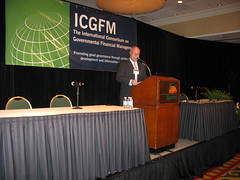
Stephen G. Fridakis , chief of IT programs and quality assurance of UNICEF. Mr. Fridakis of asks where the public sector can innovate. Can only the private sector innovate? He believes that innovation is caused by people who are angry. There is a lot of innovation in the public sector, according to Mr. Fridakis.
Mr. Fridakis discussed innovation and strategic planning in organizations. He pointed out that innovation means redesigning the organization. Operational improvements and "me too" approaches is not strategy. Planning is often incremental. Organizations rarely create, we imitate. We spend more time on analytical tools that are not effective.
Although the public sector does not have the same bottom line measurement of the private sector, there are ways to evaluate goals, according to Mr. Fridakis. The public sector can be aware of customer goals. He advocates the notion of moving from the project approach to a portfolio approach in the public sector.
Mr. Fridakis looked at the notion of public value. Public sector innovation is about new ideas that work at creating public value. Public value is an analogy to value-added in the private sector. It is not good enough to be happy internally to the organization. There needs to be more effective measurements of public value.
Capacity building in IT is critical to innovation in countries, according to Mr. Fridakis. Capacity building means reducing the reliance on foreign consultants. Organizations need to make IT innovation sustainable. And, the customer context needs to be understood.
Mr. Fridakis applied a private sector strategic framework to the public sector. This framework includes business goals, identifying the customer, products & services, and establish new controls. He has found that government reform must be in sync with innovation.
IT in UNICEF is a difficult organization to innovate because of the hierarchical organization, strong controls and decentralization, according to Mr. Fridakis. The organization operates with both a cash and an accrual basis.
Why is innovation good? Mr. Fridakis identified a number of ways:
- Improved efficiency
- Improved ease of use
- Integrates easier with the private sector
- Enables collaboration and knowledge transfer
Mr. Fridakis described the benefit of accessing policy documents over time. UNICEF is looking to store this information with taxonomies to make them easier to find.
Mr. Fridakis believes that if we have access to information, we can predict potential natural and economic disasters. He stated that "innovation is the ability to see change as an opportunity - not a threat."
Mission-driven public sector organizations can leverage technology innovation, according to Mr. Fridakis. Transparency and outreach are enabled through innovation.
Stephen Fridakis has responsibility for the oversight, coordination of IT Programs worldwide. Prior to that he was the Chief Information Security Officer of the United Nations Development Programme, the UN's global development network. He is the former Chief Security Engineer of BearingPoint, where he had enterprise-wide responsibility for IT security of government and defense contracts.





